"Primitive Rabbitkeeping" - The One-Year Recap
Experiments in small-scale symbiotic animal husbandry --- [Estimated reading time: 15 min.]
This article is an update to an earlier piece, titled The Exhilarating Journey from Grass to Meat (and Shit).
Disclaimer: the following text contains descriptions and images depicting the slaughtering of animals. Reader discretion is advised.
The first generation of our rabbits is now pretty much exactly one year old. Eight months after writing the first short introduction to our (pretty haphazard) rabbit experiment, ten months after buying three young rabbits from the local market, I finally feel confident enough to write another quick piece about our experiences.
But please be advised that this is merely an account of our own experiences, and we definitely don’t consider ourselves to be anything even close to “authorities” or “experts” on keeping rabbits. Our setup is simple – one might even say primitive1 – and the “yield” after a single year is laughable when compared to others’ (more serious) efforts.
In our defense, had we concentrated our entire focus on the rabbits (and bought an adult breeding pair), we might have gotten a lot further. But we also have cats to play with, chickens to feed, vegetables to water, books to read, articles to write, occasional guests to entertain, and both a low-tech household2 and a three-acre Food Jungle to maintain, so everything we do happens a bit slower.
This is both an upside (diverse tasks that never get boring) and a downside (everything takes longer than if you’d give it your undivided attention) of the subsistence lifestyle, I reckon. Instead of specialization and reductionism, we prefer to take the generalist’s approach, true to the motto “a jack of all trades is a master of none, but oftentimes better than a master of one.”
After six years on the land, we finally found a use for the abandoned and perpetually termite-infested bungalow in the lower part of the garden! Too small to be a guest room (and too dark to be inviting), this building was constructed twenty years ago on behalf of the previous owner, who wanted “a place to meditate” but never actually used it (or even lived here). After replacing the original wooden paneling (which we used to build beehives) with fire-treated bamboo, we still didn’t really know what to do with it, and if nobody takes care of it constantly the termites will claim it.
For the entire dry season we simply used a cardboard box and a metal roof sheet as shelter for the rabbits, but it was clear that we needed something more permanent for rainy season. So why not convert the “meditation hut” into a rabbit mansion?
Overall, we are continually amazed by how easy it is to keep rabbits. Most of our initial worries were entirely unfounded, and even the greatest threat (humidity!) has been met with stunning indifference. There’s still two months of monsoon for them to weather, but so far they are doing just fine, even during the hardest downpours. If it rains, the rabbits usually stay under the roof, and if the rain is strong enough, they wait it out inside their mansion. Even mosquitoes don’t seem to bother them too much, although we often light a few scraps of coconut fiber when we pay them longer visits to keep the swarms at bay.
Despite occasional mishaps, we are both satisfied with the progress we’ve made.
We started out rather disorganized, having spontaneously bought three baby rabbits at the local market, without the sellers even knowing the exact breed (they just called it กระต่ายบ้าน – the “common rabbit”). Just like with our general approach to permaculture, if given the opportunity we like to experiment a bit first (without absorbing too much information), in the (perhaps naïve) hope it will shield us from ingrained biases and internet myths.
Except for asking a few fundamental questions to some experienced friends (many thanks to Kay and Leon!), we proceeded through trial and error – which, by definition, entails some setbacks here and there.
The first setback for us was when the entire first litter – six tiny, almost hairless globs with giant snouts – all died within the first three days. We didn’t expect that she would give birth so early on, so we were quite surprised to find the kits laying in a hollow on the bare ground one morning. It was the first time giving birth for our matriarch, Bella, and she seemed a bit confused herself. Additionally, we still moved them around every week during that time, which might have made nest building more difficult. As soon as we found the litter, we cleared out the old Supermax behind the house for her (see first post for pictures), and built a nest into a small cardboard box. But morning after morning, more kits died. It sometimes looked like she sat on top of them while nursing, suffocating them in the process.
We were warned beforehand that there might be complications with the first litter, so it was not a huge disappointment for us. Actually, we were (and are!) continually amazed that the rabbits even made it this far!
Fortunately, shortly after this incident the next litter was born. Karn was the first one to discover the five new arrivals, hidden under (!) the deep banana hay in the corner of their bungalow.
The kits grew rapidly – for real! – and soon started running around the entire enclosure. Initially, we did have some concerns over snakes, but so far this has not been an issue at all, perhaps partly due to the fact that we walk through the area several times per day, which keeps away most snakes.
But then, earlier this month, two of her latest litter died – probably due to me feeding them too much Leucaena leaves. I’ve read before that rabbits have no problem with eating up to 100g per day of Leucaena, and we’ve never experienced any problems before. So when it was time to harvest the mature pods of our largest tree, I cut them one armful of young branches, which they devoured with great pleasure (it seems like Leucaena leaves, together with Cannabis, are their absolute favorite food). The next day I repeated the procedure, and the morning after the two rabbits were already dead (with slightly bloated stomachs).
Upsetting, but we’ve learned our lesson.
Just like we were overly careful in the beginning, this was the threshold of carelessness that we needed to cross, to know the upper boundaries of what they can safely manage. A one-time slip.
Their staple foods are still banana leaves (fresh, shredded to thin strips), the succulent foliage of ต้นมั่งมี (Carallia brachiata), hibiscus leaves & branches, sweet cassava leaves & branches, and a common herb called Asystasia gangetica, as well as biweekly loads of Leucaena (from now on with a few days buffer in between!).
Somewhat surprisingly, our rabbits are not even that interested in any of the grasses we have growing here. They sometimes eat napier grass and sugar cane leaves, but not often, and not a lot.
Apart from that, there are about two dozen plants that they enjoy eating regularly, but not in large quantities. Whenever we do slash-weeding, chop-and-drop, or weed vegetable beds and footpaths, we make sure to save the most beautiful branches for them, and we might walk by their enclosure several times a day to toss them a bundle of herbs or some leftover fruit. (From all the fruit we ever fed them, the only one they find utterly repulsive is – you guessed it – durian!)
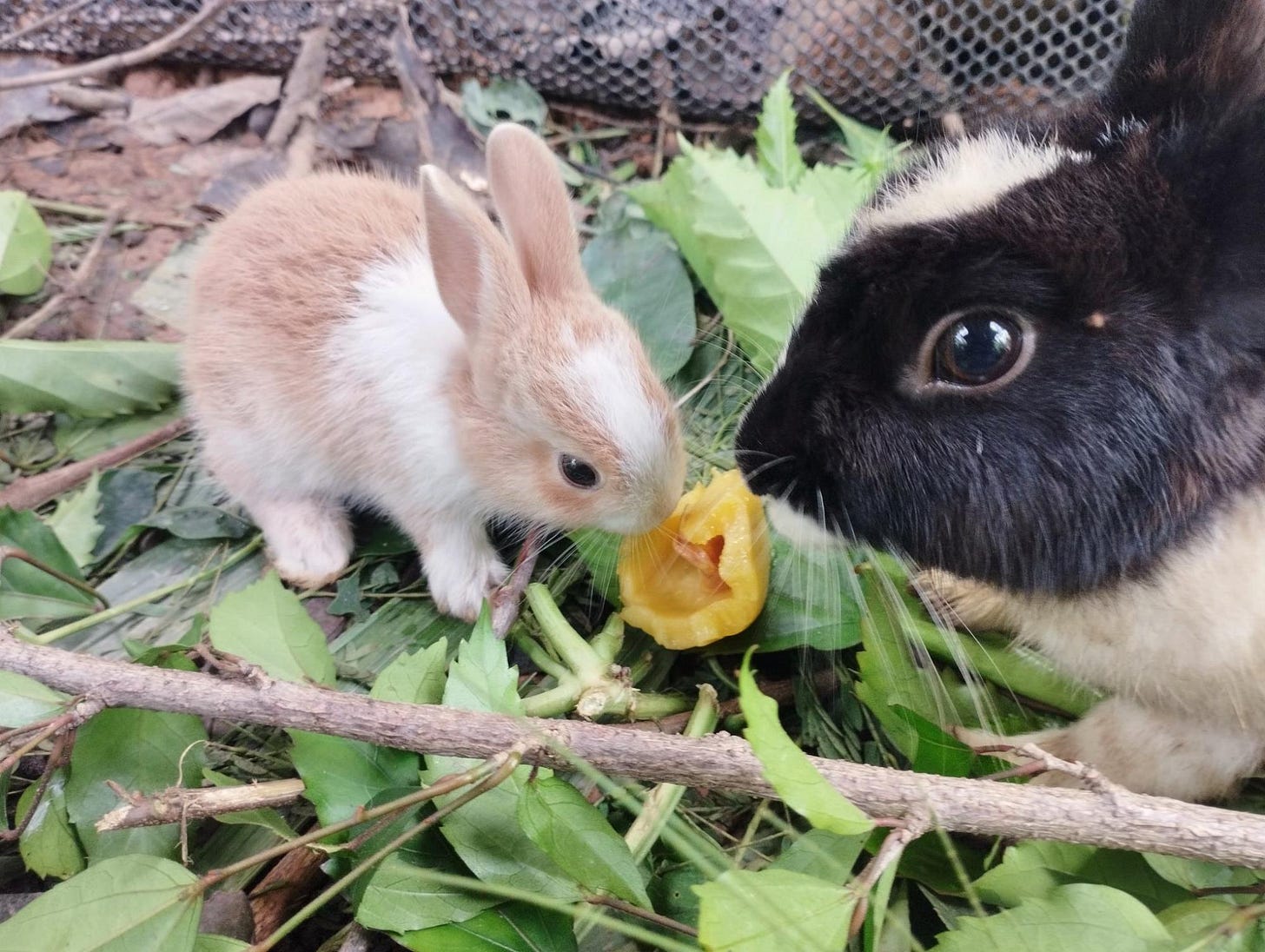
Our conclusion after the first year: in our particular conditions, rabbits are superior to chickens in every respect. Far superior. Along the board.
Feed & other expenses/tasks:
We feed our chickens a cupful of rice each day, which we can’t plant ourselves (and we don’t have any stable harvests of potential substitutes yet). After the annual rice harvest Karn always brings a sack of unhusked, pesticide-free rice for the chickens from her parents’ farm – but once it’s empty, we need to buy cheap, old rice in the market.
The rabbits, on the other hand, eat exclusively from our land. They don’t require any additional feed, despite many claims to the contrary online.
A few people in our real-world social circle warned us that rabbits “need” to eat hay or pellets, or both. This seemed strange from the beginning on, since nobody makes hay for wild rabbits, and I’d be surprised if there was any animal (including humans!) that thrives on a diet of industrially produced food. Sure, there is good-quality rabbit feed (and if you want to maximize growth it seems like pellets are necessary), but claims that they “need” a certain part of their diet to be pellets seems little more than industry propaganda.
The two plastic water dispensers for our chickens need to be filled up about once every two weeks in dry season, and once a month in rainy season. Additionally, dirt and leaves accumulate, so every few days we have to throw out some water and wipe the cup clean.
The rabbits, on the other hand, don’t seem to require any additional water at all. We make sure that they always have a small bowl of fresh water somewhere in their enclosure, but it never needs refilling (except when they knock it over or there’s mosquito larvae inside), and despite spending considerable time with them, in the entire year I’ve only ever seen a rabbit drink water once.
Even in dry season, it seems like the rabbits get most of the moisture they need straight from the vegetation, as we only feed them the freshest grasses, herbs & tree foliage. Even the one time we forgot to add a bowl of water for a few days after moving them to a new enclosure, they seemed to do just fine without it and showed no interest in the water bowl once it was there again.
Ease of management:
The chickens exterminate mulch. Keeping the ground in the chicken pen steadily covered with mulch is a Sisyphean task, especially in rainy season. Every other week, we have to prune large branches, carry them into the chicken pen, and defoliate them there (by hand or machete).
In- and outside the Rabbit Rainy Season Retreat, the mulch is getting thick fast. We do the deep litter approach, simply throwing new plant material on top. Outside their hut, there is no need for any additional litter, the leftovers of the twigs and grasses we feed them are more than adequate and build up steadily over time. As we are now about halfway through the rainy season, Karn just finished clearing the dung out, and we plan to harvest the manure a second time right after the rains stop and we re-dig our vegetable beds.
The inside of the hut is strewn several times weekly with fresh banana hay. This accumulates over time as well (while serving as a staple food basis load at the same time), and makes great nesting material for our doe.
Most importantly: the rabbits can’t fly. They usually stay within their enclosure, although there is always one time, right after moving the fence to a new place, that one of the rabbits finds a weak spot and consequently escapes.3
We were also warned that the rabbits might start digging holes under the fence, but this has so far not been an issue at all. They do dig shallow burrows in dry season, but they are not often located anywhere near the fence – they seem to prefer the base of trees, in the softer soil in between the roots. During rainy season, the rabbits don’t dig much at all, perhaps because the soil resembles pottery clay in texture. But on the single occasion when a hole started to be excavated underneath the fence in one of the corners, it was enough to put a large stone on the other side of the fence to discourage further attempts.
Scaling up:
Our chickens have between two and seven chicks per clutch, and survival rates – initially lower than 50 percent – have improved greatly after we built them a proper house and consequently snake-proofed it with plastic mesh (the same we use as a rabbit fence). We lost countless unhatched eggs and baby chicks to snakes who come at night when chickens are blind and helpless. The chickens know what’s going on, and might protest loudly, flutter their wings, or even attempt to fly away if the sensed threat is frightening enough. I am a light sleeper, so I usually wake up when there’s turmoil in the chicken cage, and consequently put on my boots, my headlamp, grab a bamboo stick and a machete, and go snake hunting. We caught four snakes over the course of this dry season, two of which we ate (the other two became cat food because I forgot to close the bucket).4
Most chicks hatch during dry season, and the chicken breed we keep yields a potential maximum of 100 eggs per annum (which, needless to say, is a number we’ve never even gotten close to). Just like other wild birds, they have a distinct breeding time, and don’t like for their chicks to be born in rainy season.5
We still lose plenty of chickens to disease (we don’t vaccinate our chicken, which is something even some of the villagers here do), to annual stray dog attacks (coordinated and executed in a spectacular and, frankly, quite impressive fashion), and to our insatiable hunger for meat (on most days we eat vegetarian, so meat is a special weekly occasion for us). The overall amount of chickens has maxed out at about a dozen, plus or minus, and the flock size has been continuous (with a few bottlenecks) for the past years.
The rabbits give litters between five and seven kits, and do so not only year-round, but much more frequently than our chickens. A bit over two months after the last litter was born, last week we found another litter of seven more kits, bringing the total to twelve rabbits after one year – and this is only from a single doe!
Barring a disease outbreak, if this growth rate continues (and especially if another doe reaches sexual maturity) rabbits might very easily become the mainstay of our diet in terms of animal protein.
Ease of dispatch & processing:
From our initial three rabbits, the decision of whom to eat and whom to spare was not an easy one. But there were two bucks and only one doe, and although the bucks didn’t actually fight much, one chased around the other quite often. Charlie was dominant, strong, even a bit aggressive at times. But he was rather lean, and had an insatiable sex drive (a positive thing, I assume?). Cha-mot, on the other hand, is gentle, but sometimes naughty (like when it’s time to move them back to their Retreat in the evenings). At first, we leaned towards slaughtering Cha-mot, as he is a good deal heavier. But we (especially Karn) had taken a liking to him, and his character ultimately saved him from the gallows, umm, the broomstick.
We dispatched Charlie via the “broomstick method” (cervical dislocation), which was a lot easier and faster than initially assumed. We’ve heard horror stories about failed attempts to use a stun gun, and problems with finding the main artery for bleeding them out, so I was a bit anxious about the process.
After asking a friend who runs a rabbitry about the strength required to snap the neck, my greatest worry was that I wouldn’t pull hard enough on the first try – yet the neck snapped before I even really started pulling.
Extremely fast, easy and convenient!
Our chickens are dispatched via bleeding out, which is not my favorite method, but overall the best choice (for us, not necessarily for the chickens). Cervical dislocation (“neck pulling”) is quite difficult with our chicken breed, because they have extremely strong neck musculature, and I don’t feel like trying unsuccessfully too many times. In addition, we use the blood as a food ingredient, and crushing the neck with the dull end of a machete before exsanguination led to a much smaller blood yield. So we hold them tight, cut their throat right underneath the head, and they go to sleep within under a minute.
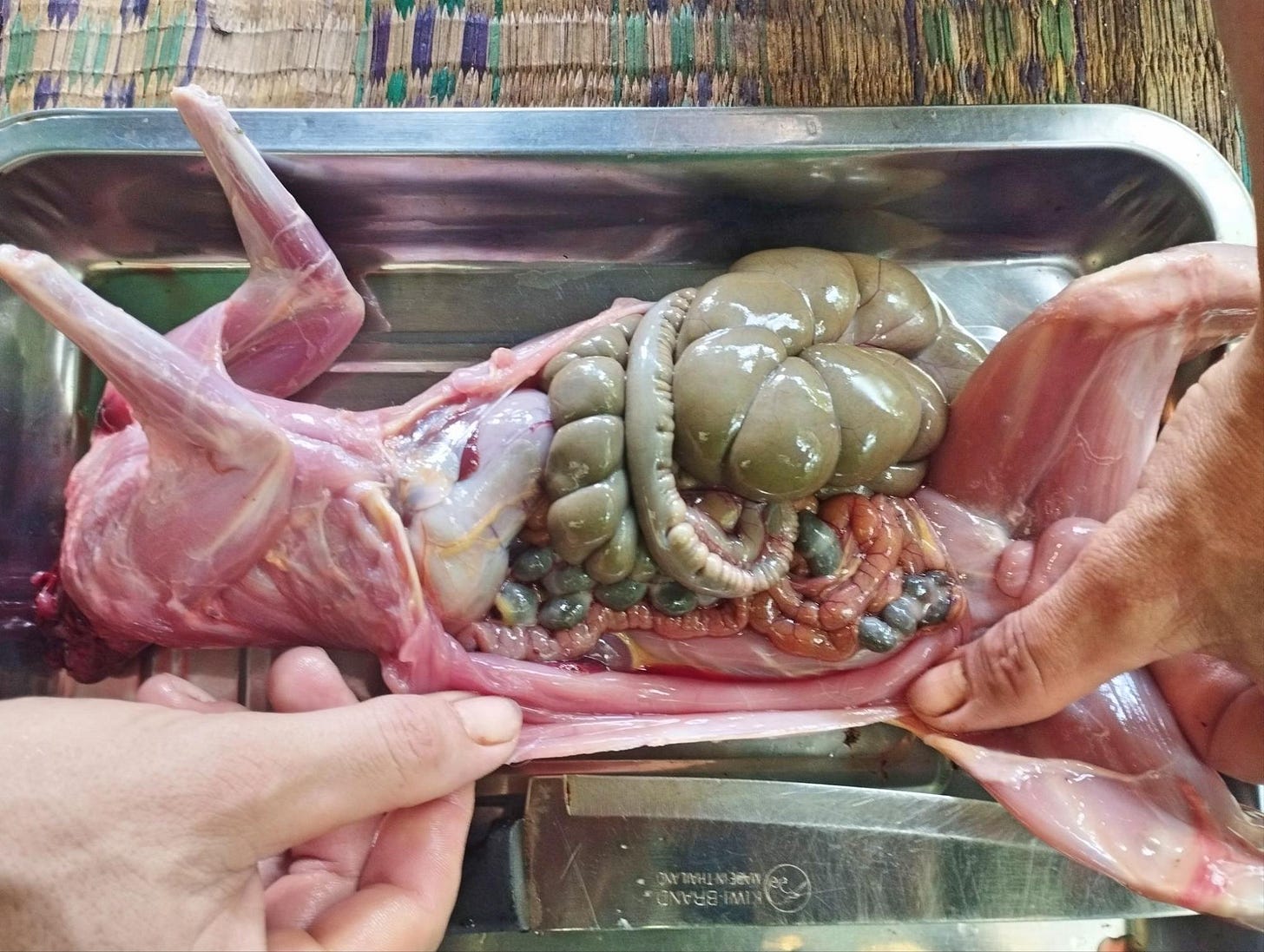
Processing Charlie took about an hour, and could have easily been done in half that time. For reference, last time we processed a chicken it took us exactly one hour, with plucking taking up most of the time. Processing squirrels is only slightly faster, because instead of feathers we have to pull out the fur (which takes a while).6 Since it was the first time for us processing one of our rabbits (or rabbits in general, really), we took time to weight specific parts and calculate total net weight, as well as document each step of the process.
Pulling the hide off was a bit more difficult than I imagined, but I suspect that my technique might improve with time.7
Preparation & taste:
Initially, we were divided over which way to prepare the animal, but we ultimately decided to barbecue the extremities and make a “sour soup” from the rib cage, head and organs – a sufficient compromise.
Both dishes far exceeded our expectations. Plenty of savory, juicy strips of meat, which was much more tender8 than any of our chickens, and had no distinct strong smell like that of rodents.
Our chickens taste absolutely amazing, especially when compared with store-bought chicken meat – exactly the same taste I remember from my grandmothers backyard chickens. But, while being great for soups and stews, they are simply too chewy for making grilled chicken.
Additionally, the brain (my favorite part of any animal) is difficult to access and prohibitively tiny in chickens (no offense!), but not in rabbits.
Future prospects:
If the next years will be anything like the present one, we might shift our attention more towards the rabbits. We won’t get rid of the chickens, we love them way too much and have integrated them well into the emerging Food Jungle ecosystem. But we might reduce the size of the flock a bit (from about 15 to anywhere between 5-10 mature individuals), to decrease both external inputs and disturbance to our carefully laid-out mulch.
Meat rabbit breeds are difficult to find, but we would be open to experiment if an opportunity arises. (For experimental purposes, we would even like to try to keep a pair of what’s locally known as กระต่ายป่า, “wild rabbits” – actually not rabbits per se, but probably the Siamese hare, Lepus peguensis ssp. siamensis – but we only saw one once in six years. Cross-breeding is probably not possible, but we’d simply like to see what happens.)
Our rabbits might be tiny when compared to meat rabbits, but compared to squirrels, tree shrews, doves and most snakes they are a real feast – and the overall meat yield per animal is pretty much exactly that of our rather lean chickens.
A recent post (with a headline typical for contemporary internet culture) in the r/Permaculture subreddit caught my attention. Here was someone reporting surprising successes after one year of keeping meat rabbits in an unconventional (but more “natural”) fashion, similar to what we are doing with ours. So, who knows, if we find the time (and the money!) for it, we might even try to buy a breeding pair of meat rabbits and see if they can survive as well as our present colony.
Definitely well worth a try for anyone practicing tropical permaculture/horticulture!
tl;dr:
Rabbits > chickens. Overall rating: 10/10, would recommend.
I write stuff like the above in my free time, when I’m not tending the piece of land we’re rewilding here at Feun Foo. As a subsistence farmer by profession I don’t have a regular income, so if you have a few bucks to spare please consider supporting my work with a small donation:
If you want to support our project on a regular basis, you can become a Patron for as little as $1 per month - cheaper than a paid subscription!
Using the term “primitive” really only implies that we don’t have any fancy equipment, not even a water dispenser - with the exception of the plastic fence, of course. It would take us ages to manufacture a similarly functional fence from local, natural materials. Thanks to the fossil fuel industry, I guess?
For instance, few people today appreciate how much time their washing machine saves them!
Also somewhat surprisingly, they never venture too far and always come back right to our house on their own accord.
Our general rule for the killing of animals is ฆ่าแล้วต้องกิน (kâa láew dtông gin) - “If you kill it, you gotta eat it.”
Which doesn’t mean that it won’t happen anyway occasionally. But sometimes they also just lay eggs without ever starting to brood.
People in Southeast Asia (and elsewhere in the tropics, I assume) don’t skin rodents, but pull out the fur and singe off the remaining hair. The skin becomes chewy (and even a bit crunchy) during the grilling.
As humidity is prohibitively high in rainy season, we didn’t even try to do anything with the hide.
Next time, we might even slaughter a month or two earlier (at 10-11 months), since the meat might be even more tender then.



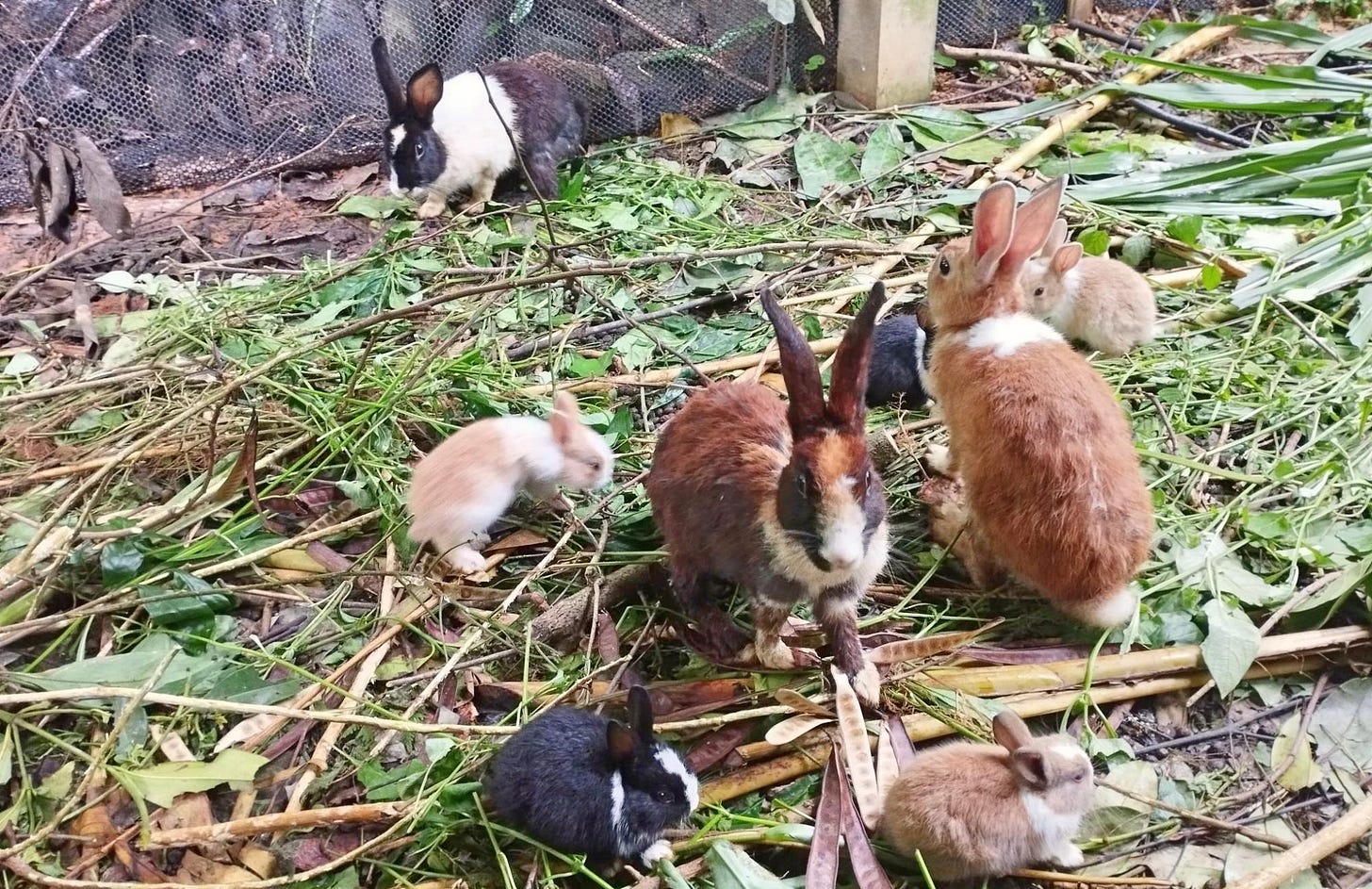
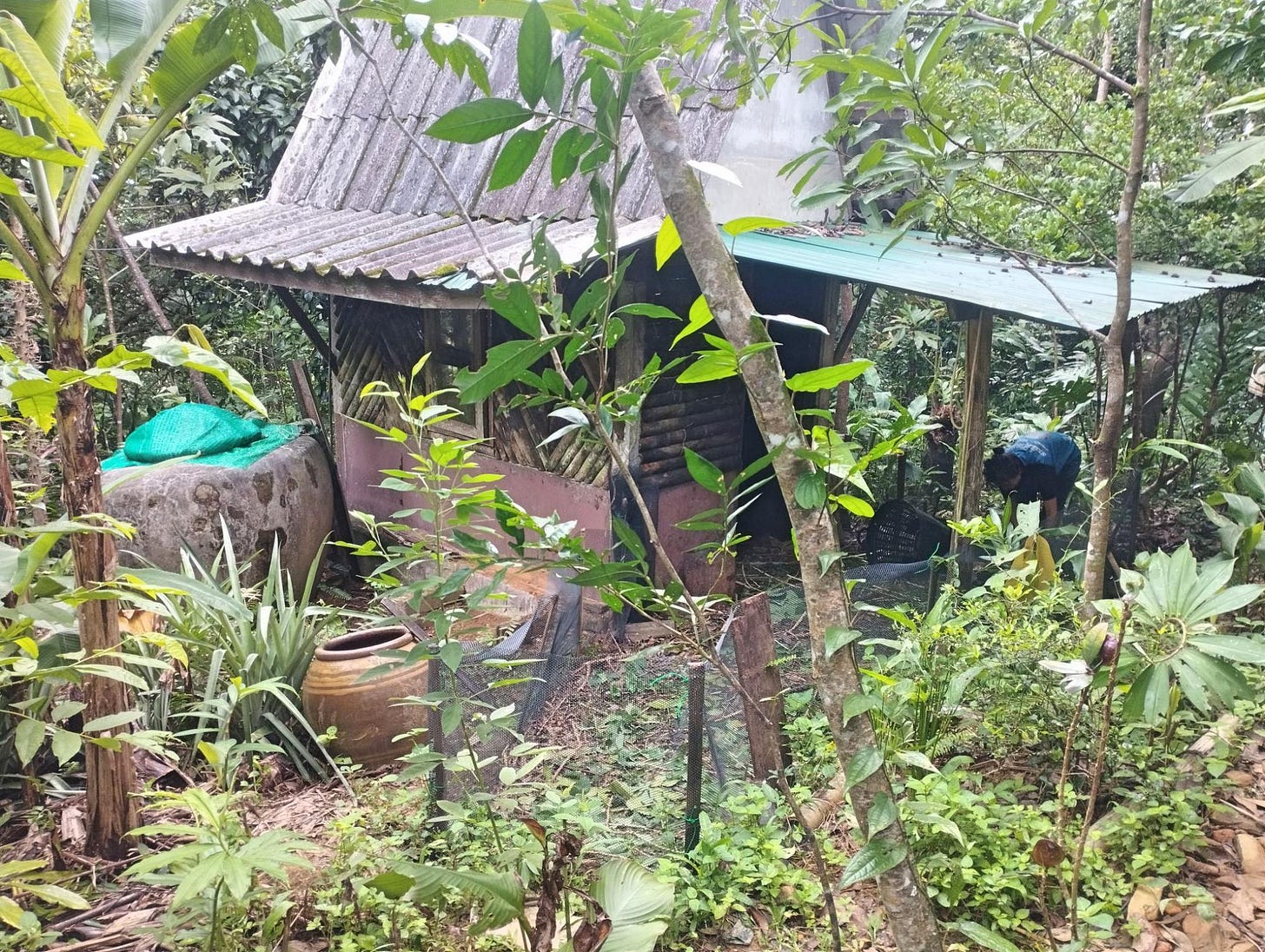
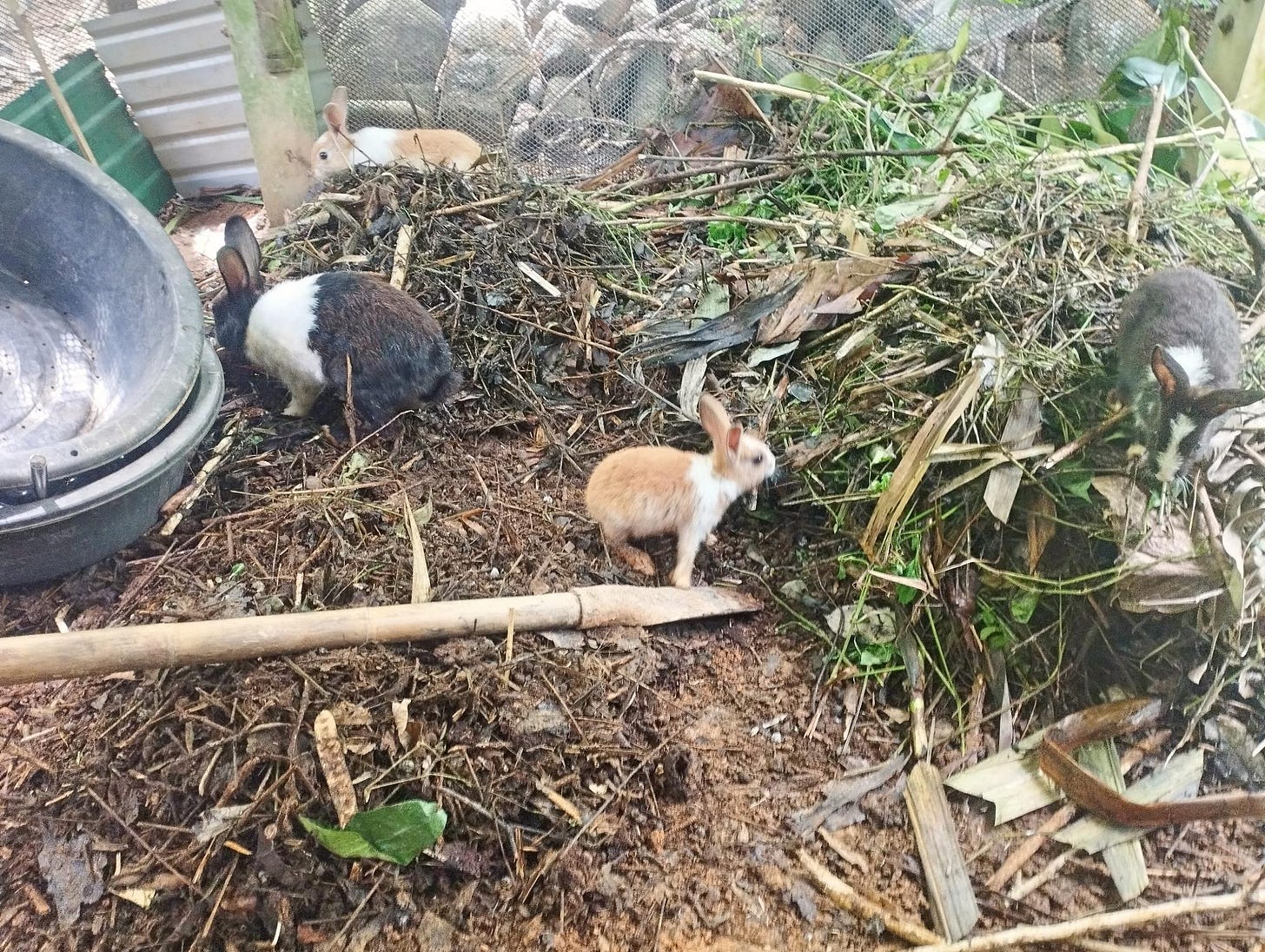
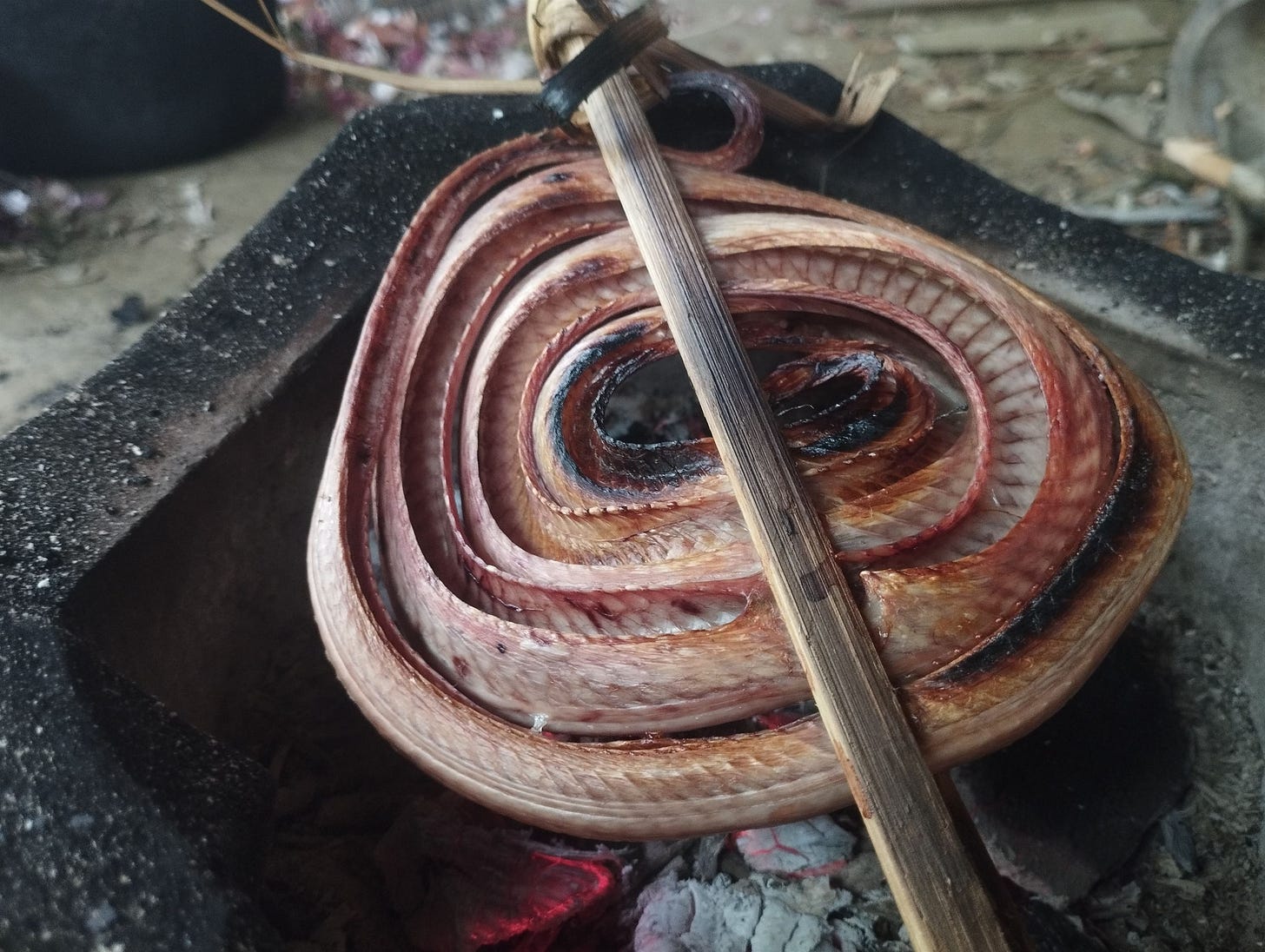
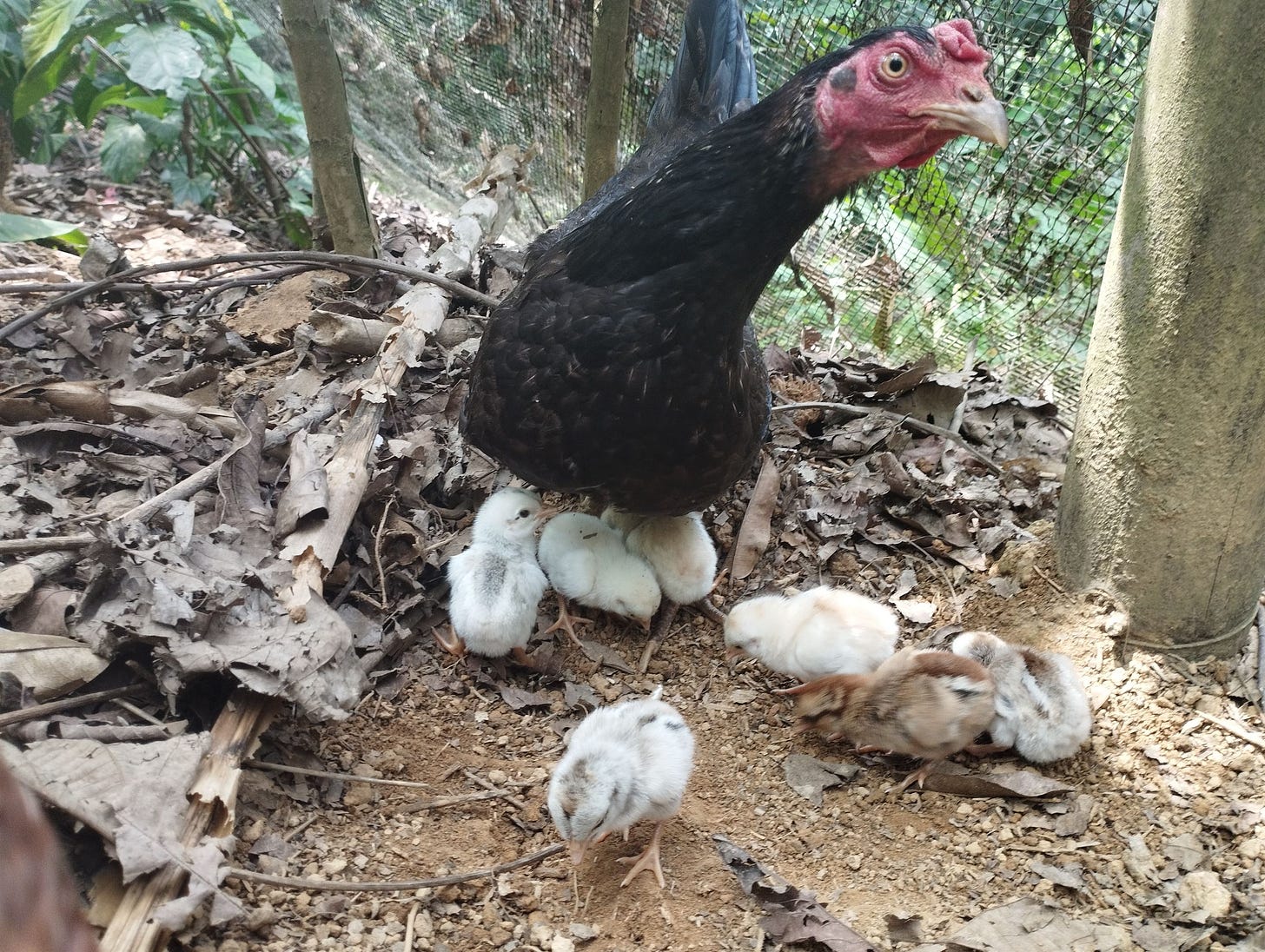
I'm really really happy to hear the rabbits are working out for you guys. I was similarly surprised with the ease of rabbits, but it wasn't until year 2 with rabbits on the ground that I began seeing problems with coccidia - but they were also sharing their space with chickens etc. (I say this in response to the reddit thread asking "why does no one know about this?" )
there are FB groups in many states here of large numbers of people specifically colony raising and feeding naturally. a good number of us do it, but disease management is the #1 challenge. keeping as sanitary conditions as possible and selecting for coccidia resistance is the way through this challenge - so at this point I am no longer bringing in new blood and am only breeding my own stock who have been exposed and survived - choosing new breeding stock from the litters at least once a year to allow for quick generation turnover.
I agree that the pellet industry has mind washed folks. the very first rabbit manual I read literally
said "ONLY feed pellets and keep in cages, if you deviate YOUR RABBITS WILL DIE" which makes no sense if you know that at some point in these animals relatively recent genetic history they were wild.
Yes anything in the legume family I try to feed in moderation. they do like it but too much does seem to cause problems.
I have done the same as you intend and cut down my chicken flock drastically. I do really like having my birds but they are so comparatively inefficient.
That other hate species you mentioned looks really interesting. I bet the meat is very different as the meat from our native wild rabbits vs the domestic is wildly different. our north American wild rabbits cannot breed with the European domestics either.
it sounds like a really cool experiment! congratulations on your success! your buns look very healthy and happy
David,
Finally able to read this, very interesting stuff. A few thoughts.
1) Is it more efficient or better to have the rabbits penned and bring the food to them, as it seems like you are doing (correct me if I am wrong)? Or could you potentially free range them. On that note, does the meat yield for rabbits exceed the equivalent in chicken eggs when that extra time investment is considered?
2) it is interesting to me that all tropical diets seem to be protein deficient as the main limiting factor. Do you plant any protein based crops to have as a staple of your diet?
And on that note, seconding the experimenting with guinea pigs. Would be very interesting to see how that turned out.